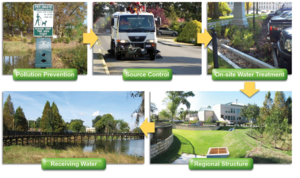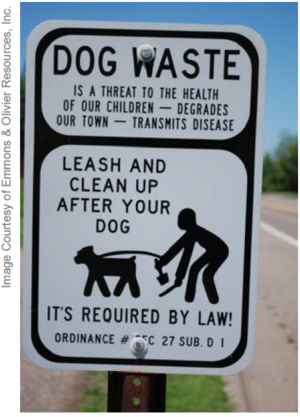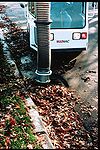
This page is in development
In water quality monitoring, specific disease-producing (pathogenic) organisms are not easily identified. Testing for them is difficult, expensive, and time-consuming. Instead, fecal coliform and E. coli, two closely related bacteria groups, can indicate the presence of pathogens. Fecal coliform and E. coli found in Minnesota rivers and steams may come from human, pet, livestock, and wildlife waste and are more common in heavily populated or farmed areas. Bacteria may reach surface water through malfunctioning or illicit septic system connections, urban stormwater, manure spills or runoff, and more.
This page provides information on bacteria in urban stormwater, including a discussion of sources of bacteria and management strategies for minimizing bacteria loading from urban stormwater runoff to surface water. Note that the focus is on bacteria because bacteria are used as a surrogate for assessing potential contamination by pathogenic microorganisms. A short section on this page specifically discusses pathogens and their relationship to indicator bacteria.
Contents
Source and concentrations of bacteria in urban stormwater
| Land use | Median (mg/L) | Minimum (mg/L) | Maximum (mg/L) | Number of observations |
|---|---|---|---|---|
| Commercial | ||||
| Industrial | ||||
| Residential | ||||
| Open space |
Meeting bacteria water quality targets
Information on this page can be used to help meet water quality targets. Water quality targets are established for various purposes including meeting Clean Water Act (CWA) requirements, meeting local water quality goals or requirements, and meeting non-regulatory targets. CWA requirements include antidegradation, TMDL limits, and NPDES permit requirements. Each of these are described below.
Antidegradation
Total Maximum Daily Loads (TMDLs)
Stormwater management for bacteria

Management of urban stormwater to control or reduce bacteria concentrations and loading should focus on identifying the most important sources and employing specific practices to address those sources. If significant reductions in bacteria loading are required or desired, a treatment train approach should be utilized. The treatment train approach for bacteria focuses on implementing the following hierarchy of practices:
- pollution prevention and source control
- pre-treatment for structural BMPs
- infiltration
- settling
- filtration
Construction stormwater
Pollution prevention and source control
These practices reduce the amount of bacteria generated or remove bacteria prior to it being entrained in runoff. These are summarized below for residential, municipal, and industrial sources.
Prevention practices for residential areas
The following table summarizes residential prevention practices that are effective at reducing bacteria concentrations. The table indicates the relative effectiveness of each practice and provides a short description of the practice. Bacteria removal efficiencies are not established for these BMPs.
Residential pollution prevention methods effective for controlling or reducing phosphorus.
Link to this table
| Practice | Relative effectiveness | Method | Image1 |
|---|---|---|---|
| Fertilizer and pesticide management | High | Reduce or eliminate the need for fertilizer and pesticides by practicing natural lawn care, planting native vegetation, and limiting chemical use; follow Minnesota Statutes Chapter 18C and federal regulatory requirements on fertilizer and pesticide storage and application if used. | |
| Litter and animal waste control | High | Properly dispose of pet waste and litter in a timely manner and according to local ordinance requirements. | |
| Yard Waste Management | High | Prevent yard waste from entering storm sewer systems and water bodies by either composting or using curbside pickup services and avoiding accumulation of yard waste on impervious surfaces; keep grass clippings and leaves out of the street. | |
| Better Car and Equipment Washing | Moderate | Wash cars less often and on grassy areas using phosphorus free detergents and non-toxic cleaning products or use commercial car washes to prevent dirty wash water from flowing to storm sewer systems and water bodies. | |
| Septic tank maintenance | High | ||
| Native Landscaping | High | Reduce turf areas by planting native species to reduce and filter pollutant-laden runoff and prevent the spread of invasive, non-native plant species into the storm sewer system. | |
| Better Sidewalk and Driveway Deicing | Moderate | Reduce or eliminate the need for deicing products by manually clearing sidewalks and driveways prior to deicer use; use environmentally-friendly deicing products when possible, apply sparingly and store properly if used. | |
| Exposed Soil Repair | High | Use native vegetation or grass to cover and stabilize exposed soil on lawns to prevent sediment wash off. | |
| Healthy Lawns | Moderate | Maintain thick grass planted in organic-rich soil to a height of at least 3 inches to prevent soil erosion, filter stormwater contaminants, and absorb airborne pollutants; limit or eliminate chemical use and water and repair lawn as needed |
Prevention practices for municipalities
The following table summarizes municipal prevention practices that are effective at reducing bacteria concentrations. The table indicates the relative effectiveness of each practice and provides a short description of the practice. Bacteria removal efficiencies are not established for these BMPs.
Municipal prevention practices for TP.
Link to this table
| Practice | Relative effectiveness | Method | Image1 |
|---|---|---|---|
| Proper Vehicle Management | High | Ensure that vehicles are fueled, maintained, washed and stored in a manner that prevents the release of harmful fluids, including oil, antifreeze, gasoline, battery acid, hydraulic and transmission fluids, and cleaning solutions. | |
| Better Turf Management | High | Ensure that mowing, fertilization, pesticide application, and irrigation are completed in ways that will prevent or reduce grass clippings, sediment, and chemicals from entering storm sewer systems; use native vegetation where possible. | |
| Sanitary Sewer Maintenance | High | Regularly inspect and flush sanitary pipes to ensure that there are no leaks in the system and that the system is properly functioning. | |
| Litter and Animal Waste Control | High | Mandate litter and pet waste cleanup within the community and control waste-generating wildlife, such as geese; provide waste containers for litter and pet waste in public areas. | |
| Temporary Construction Sediment Control | Moderate | Implement and encourage practices to retain sediment within construction project area; see Temporary Construction Erosion and Sediment Control Factsheets for additional information | |
| Wind Erosion Control | Moderate | Institute a local program for wetting of open construction surfaces and other sources for windblown pollutants. | |
| Streambank Stabilization2 | Moderate | Repair erosion occurring on a streambank of lakeshore in a timely manner; inspect bank areas for ice damage in the spring. | |
| Material Storage Control | Moderate | Reduce or eliminate spill and leakage loss by properly inspecting, containing, and storing hazardous materials and having a cleanup plan that can be quickly and efficiently implemented. | |
| Dumpster and landfill management | Moderate | Ensure that contaminated material is contained to prevent solid and/or liquid waste from being washed into storm sewer systems or water bodies. | |
| Better Street and Parking Lot Cleaning | Moderate | Maintain streets and parking lots frequently and especially in the spring by sweeping, picking up litter, and repairing deterioration; pressure wash pavement only as needed and avoid using cleaning agents. | |
| Storm Sewer System Maintenance | Moderate | Regularly clean debris from storm sewer inlets, remove sediment from catch basin sumps, and remove any illicit connections to storm sewer systems. | |
| Public Education | Moderate | Label storm drains to indicate that no dumping is allowed and institute pollution prevention programs to educate and implement needed community practices. | |
| Staff, Employee, and Volunteer Education | Moderate | Provide internal training for staff and provide direction to hired employees or volunteers regarding pollution prevention techniques to be used during work activites. |
1 Photo credits
2Reductions in pollutant loading associated with this BMP are not eligible for credit toward NPDES permit requirements unless the stabilization is above the ordinary high water mark (i.e. the work is not completed within a Water of the State), prior to a permittee's discharge, and the load reduced from this action is included in a Wasteload Allocation in a U.S. EPA-approved TMDL.
Prevention practices for industrial sources
The following table summarizes industrial prevention practices that are effective at reducing bacteria concentrations. The table indicates the relative effectiveness of each practice and provides a short description of the practice. Bacteria removal efficiencies are not established for these BMPs.
Industrial prevention practices for TP.
Link to this table
| Practice | Relative effectiveness | Method | Image1 |
|---|---|---|---|
| Better Turf Management | High | Ensure that mowing, fertilization, pesticide application, and irrigation are completed in ways that will prevent or reduce grass clippings, sediment, and chemicals from entering storm sewer systems; use native vegetation where possible. | |
| Proper Vehicle Management | High | Ensure that vehicles are fueled, maintained, washed and stored in a manner that prevents the release of harmful fluids, including oil, antifreeze, gasoline, battery acid, hydraulic and transmission fluids, and cleaning solutions. | |
| Sanitary Sewer Maintenance | High | Regularly inspect and flush sanitary pipes to ensure that there are no leaks in the system and that the system is properly functioning. | |
| Temporary Construction Sediment Control | Moderate | Implement and encourage practices to retain sediment within construction project area; see Temporary Construction Erosion and Sediment Control Factsheets for additional information | |
| Wind Erosion Control | Moderate | Institute a local program for wetting of open construction surfaces and other sources for windblown pollutants. | |
| Material Storage Control | Moderate | Reduce or eliminate spill and leakage loss by properly inspecting, containing, and storing hazardous materials and having a cleanup plan that can be quickly and efficiently implemented. | |
| Dumpster and landfill management | Moderate | Ensure that contaminated material is contained to prevent solid and/or liquid waste from being washed into storm sewer systems or water bodies. | |
| Better Street and Parking Lot Cleaning | Moderate | Maintain streets and parking lots frequently and especially in the spring by sweeping, picking up litter, and repairing deterioration; pressure wash pavement only as needed and avoid using cleaning agents. | |
| Storm Sewer System Maintenance | Moderate | Regularly clean debris from storm sewer inlets, remove sediment from catch basin sumps, and remove any illicit connections to storm sewer systems. |
Street sweeping
Several articles in the literature present results from street sweeping studies. Examples include the following.
- Selbig and Bannerman (2007) discuss changes in pollutant loading for regenerative-air, vacuum-assist, high-frequency broom, and low-frequency broom sweeping practices.
- Law et al. (2008) found for a given set of assumptions and sweeping frequencies, it is expected that the range in pollutant removal rates from street sweeping for total solids was 3 to 8 percent, with the lower end representing monthly street sweeping by a mechanical street sweeper and the upper end the pollutant removal efficiencies using regenerative air/vacuum street sweeper at weekly frequencies.
- Sutherland (2011) provides a comprehensive summary of street sweeping, including information on effectiveness of different sweepers and factors affecting the performance of street sweeping.
Pretreatment
Pretreatment is needed to protect infiltration and filtration BMPs from the build-up of trash, gross solids, and particulate matter. When the velocity of stormwater decreases, sediment and solids drop out. If pretreatment is not provided, this process will occur in the infiltration or filtration cell, resulting in long-term clogging and poor aesthetics. Therefore, pretreatment is a required part of the design for infiltration and filtration BMPs. There are three typical methods for pretreatment: vegetated filter strips (VFS), forebays, and vegetated swales. These are discussed in the section on pretreatment.
Infiltration
Infiltration practices are structural Best Management Practices (BMPs) designed to capture stormwater runoff and allow the captured water to infiltrate into soils underlying the BMP. Infiltration BMPs are designed to capture a particular amount of runoff. For example, the construction stormwater permit requires that post-construction BMPs capture the first inch of runoff from new impervious surfaces, assuming there are no constraints to infiltration. BMPs designed to meet the construction stormwater permit are required to infiltrate captured water within 48 hours, with 24 hours recommended when discharges are to a trout stream.
Bacteria removal is assumed to be 100 percent for all water that infiltrates. Any water bypassing the BMP does not receive treatment. Examples of infiltration BMPs, with links to appropriate sections in the Manual, include the following.
- Infiltration (infiltration basin, infiltration trench, dry well, underground infiltration)
- Bioinfiltration (rain garden or bioretention with no underdrain)
- Permeable pavement
- Tree trench/tree box
- Swales with a bioinfiltration base
Additional BMPs that result in infiltration include stormwater and rainwater harvest with irrigation and impervious surface disconnection. For these BMPs infiltration typically occurs into turf or other vegetated areas. Disconnection of impervious surface does not qualify for credits for meeting the Construction Stormwater permit. Harvest BMPs do qualify for credit because they capture an instantaneous volume of water.
The links above take you to the main page for each BMP. Each BMP section has a page on pollutant credits. These credit pages provide information on runoff volume and pollutant removal for the BMP, including credits that can be applied to meet a performance goal such as a Total Maximum Daily Load (TMDL).
In soils where there are constraints on infiltration, BMPs may be designed with underdrains. Unless the BMP is lined, some water will infiltrate through the bottom and sides of the BMP. Bacteria removal for the portion of captured runoff that infiltrates is 100 percent. Water draining to the underdrain undergoes some treatment. These BMPs are discussed in more detail in the filtration section below.
Settling practices
If prevention, source control and infiltration practices cannot fully meet protection or restoration targets for stormwater, settling and filtration practices may be used. Settling practices include constructed stormwater ponds, including variants, and constructed stormwater wetlands, including variants. Manufactured devices and forebays are both settling practices but are primarily used for pretreatment.
Information on design, construction, operation and maintenance, credits, and other characteristics of these BMPs can be found on the main pages for constructed stormwater ponds and constructed stormwater wetlands.
Filtration practices
Filtration practices are typically used when infiltration practices are not feasible, such as areas with low infiltration soils or shallow bedrock (see section on infiltration constraints. Filtration practices include bioretention with underdrains, media filters, and swales. Vegetated filter strips are often used as a pretreatment practice.
Information on design, construction, operation and maintenance, credits, and other characteristics of these BMPs can be found on the main pages for media filters and swales, green roofs, and bioretention.



















